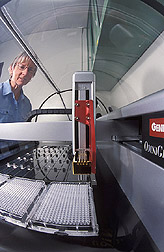|

Technician Sharon
Horn monitors robotic equipment as it imprints Campylobacter microarrays
on glass slides. Click the image for more information about
it.
Read the
magazine
story to find out more.
|
Unmasking the Genes of Food-Poisoning
Campylobacter By
Marcia Wood
October 1, 2004
What's your favorite way to prepare chicken? Whether you grill,
fry, roast or bake it, as long as you cook it thoroughly, you'll kill any
Campylobacter jejuni food-poisoning bacteria that may be on or in it.
But raw chicken juice, or raw or undercooked chicken, could
harbor this microbe and lead to campylobacteriosis food poisoning. In fact,
Campylobacter is thought to be the leading cause of food poisoning
worldwide.
To foil Campylobacter, Agricultural Research Service scientists in
Albany, Calif., and their colleagues at The
Institute for Genomic Research, Rockville, Md., have decoded the sequence,
or structure, of all of the genes in a specially selected C. jejuni
strain.
Investigations of these C. jejuni genes may lead to the
discovery of faster, more reliable ways to detect the microbe in samples from
food, animals, humans and water.
What's more, the gene-based research opens the door to simpler,
less-expensive tactics for distinguishing look-alike species and strains of
Campylobacter and its close relatives, so that culprit microbes in food
poisoning outbreaks can be fingered more quickly.
Finally, the studies may lead to innovative, environmentally
friendly techniques to circumvent the genes that make C. jejuni strains
so successful in causing human gastrointestinal upset and, in some cases,
paralysis or even death.
The research represents the first time that a C. jejuni
strain from a farm animal--in this case, a market chicken--has been
sequenced. That farm-animal origin is important, because chicken is the leading
source of this bacterium in food. Earlier C. jejuni genome sequencing,
done elsewhere, was based on a specimen from a gastroenteritis patient and was
lacking key features, such as the ability to colonize chickens.
Read more
about the research in the October issue of Agricultural Research
magazine.
ARS is the U.S. Department of
Agriculture's chief scientific research agency. |